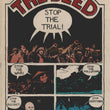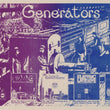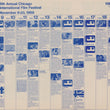



1969 The Seed, Vol. 4, No. 8
By: Seed Publishing Co.
Date: 1969
Dimensions: 16.5 x 11.5 inches (41.9 x 29.2 cm)
The Seed, Vol. 4 No. 8. with a humorous cartoon graphic on the cover protesting the trial of the Chicago Eight (later seven), Vietnam war, air pollution, bullshit, and life itself. With a general focus on the trial of the Chicago Eight, a group of activists facing charges stemming from the protests during the 1968 Democratic National Convention, where anti-Vietnam War activists clashed with police in Chicago. Originally charged as the Chicago Eight, the group—comprised of activists including Abbie Hoffman, Tom Hayden, and Bobby Seale—was accused of conspiracy and inciting a riot. The trial highlighted the tension between the government and the rising tide of activism. Though five of the defendants were initially convicted of inciting riots, their convictions were overturned on appeal due to issues with the judge’s conduct and the biased handling of the case. Bobby Seale's trial was eventually separated after he was gagged and bound in court for repeatedly asserting his right to self-representation. This issue also features an article on Joe Hill, as well as contributions from cartoonist Robert Crumb, New York poet Anne Waldman and a page displaying the schedule for the 5th Annual Chicago International Film Festival.
The Chicago Seed was an underground newspaper that operated between 1967 and 1974 in Chicago. It was part of the countercultural press and focused on issues related to the anti-Vietnam War movement, civil rights, environmentalism, and the broader hippie and radical left movements.
The Seed was first published from the offices of the Community News Service, located at 950 West Wrightwood Avenue in Chicago, Illinois. As the paper grew in popularity, it moved to a few different locations, including spaces in Old Town and Lincoln Park neighborhoods, both of which were hubs for Chicago's counterculture during the 1960s and early 1970s.
These neighborhoods were home to activists, artists, and other members of the city's youth and political movements, making them a natural base for the underground newspaper's operations.
The paper featured a mix of political articles, artwork, and alternative culture content, often with a psychedelic aesthetic, reflecting the anti-establishment sentiments of the time. It was among the most important publications in the 1960s underground press movement, challenging mainstream media narratives and promoting progressive social change.
Condition: Good and stable overall with original folds, wear to edges and bumps to corners.
Inventory #92217
1200 W. 35th St. #425 Chicago, IL 60609 | P: (312) 496 - 3622





